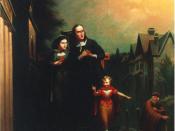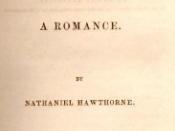Symbolism in the Scarlet Letter
Symbolism is very important throughout the Scarlet Letter written by Nathaniel Hawthorne. According to Henry James, the famous American novelist, he believes the symbolism is overdone. Others think the symbolism is just right to know what is going on through Hawthorn's wordiness. Throughout the entire book, Hawthorne used various kinds of symbolism. Hawthorn's symbolism helped make the story line cleaner and brought the characters to life. He often used symbolism to justify a point or to describe and idea. Hawthorns' symbolism also helped with understanding the character's emotions at that particular time.
The Scarlet Letter is about sin. The rosebush growing at the prison door symbolizes beauty in the midst of evil. The scarlet letter upon Hester Prynne's bosom, that is so beautifully embroidered, represents sin cloaked in beauty, and a secret for Pearl never to know. When Pearl asks her repeatedly what it means Hester tells her to "hold her tongue."
When Pearl asks her if it was the Black Man in the forest Hester says, "Once in my life I met the Black Man, this scarlet letter is his mark," only so Pearl would leave her at peace. (Page 182) The Black Man symbolizes the devil or one of his demons. Pearl is the extraordinary child. Hester dresses her in vivid colors, with elaborate detail, much like her own scarlet letter. Pearl is the most important part of Hester's life. She was truly a pearl of great price. In the forest, Pearl could catch the sunshine, but Hester could not. "Mother the sunshine does not love you. It runs away and hides itself, because it is afraid of something on your bosom." (Page 180) Hester and Pearl lived in a cottage hidden from view, as if there was something to hide.


